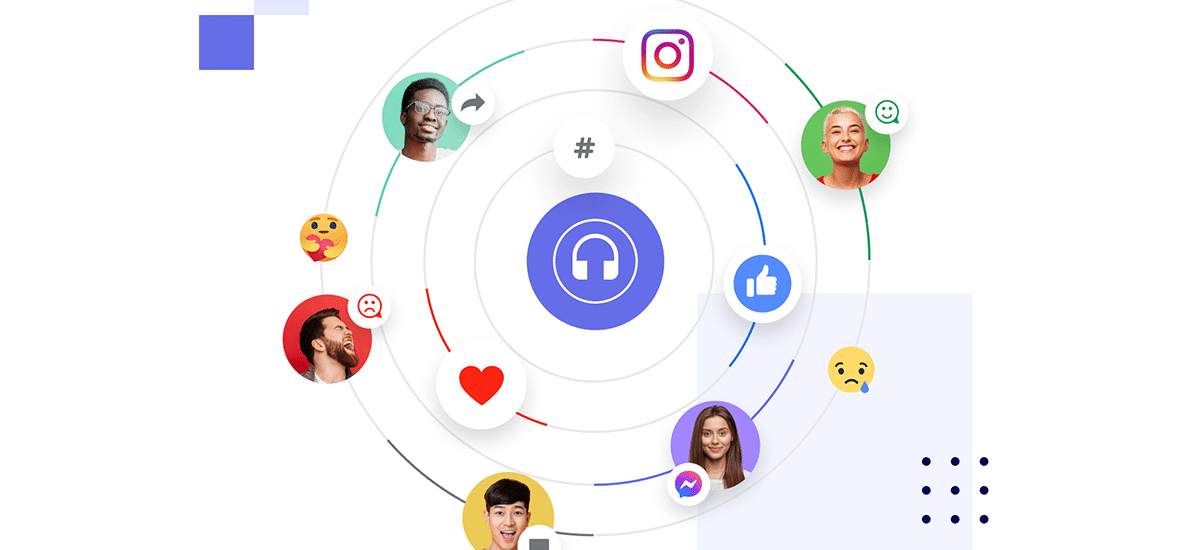Millions of conversations are taking place online every second. People discuss brands, products, services, industries, and rivals in various social media channels, forums, blogs, news sites, and online customer communities. Social media monitoring is the practice of identifying these conversations, whether they take the form of feedback, questions, discussions, or complaints, and then determining what’s being said, by whom, and how those users are sharing feedback or expressing sentiment for your brand.
It is often mistaken for social media moderation, yet according to the age-old definitions of each, they play a very different part. Social media monitoring is about listening to web conversations, whereas moderating is about participating in the conversation and guiding the interaction. Both matter, but tracking provides a unique window into public opinion and sentiment.
Table of Contents
What is social media monitoring?
Social media monitoring involves listening for what others are saying about your company, products, and services and your industry, and then identifying who will say it using digital conversations about your brand. A social media finder can help locate the profiles or accounts behind these mentions, making it easier to track and engage with relevant users. It’s not just your basic social channels— Facebook (X), Instagram, Twitter (X), LinkedIn, TikTok, and YouTube — that are subject to this practice, but also blogs, forums, news sites, and other classroom-like online communities.
At its most basic level, social media monitoring provides answers to these questions:
- Who is talking about your brand?
- Where are these conversations happening?
- What are people saying?
- How do they feel about your brand, products, or services?
This intelligence can be used by businesses to make informed decisions, improve customer relationships, protect their reputation, and validate new opportunities.
How to do social media monitoring effectively
To maximize the benefits of social media monitoring, brands must adopt a structured approach:
1. Set clear goals and metrics
Define your objectives, such as:
- Improving customer satisfaction.
- Growing brand awareness.
- Increasing sales or conversions.
- Managing reputation.
Once goals are set, establish measurable key performance indicators (KPIs) like:
- Number of brand mentions.
- Sentiment score.
- Engagement rate.
- Share of voice.
- Customer response time.
2. Choose the right monitoring tools
An essential part of any monitoring strategy is selecting effective social listening tools. These tools streamline and automate the process by:
- Monitor multiple platforms.
- Provide real-time alerts.
- Offer sentiment analysis.
- Support keyword and hashtag tracking.
- Deliver actionable analytics.
3. Set up comprehensive search queries
Effective monitoring relies on choosing the right keywords and search terms, including:
- Brand names (and misspellings)
- Product and service names
- Slogans and taglines
- CEO or spokesperson names
- Industry-specific keywords
- Competitor names and hashtags
- Customer-generated nicknames or slang
Casting a wide net ensures no valuable conversation slips through unnoticed.
4. Focus on relevant platforms
Monitor where your audience is most active. While major platforms like Facebook and Twitter are essential, also consider:
- Reddit communities
- Niche forums
- Industry-specific blogs
- News outlets
- Review sites (e.g., Yelp, Trustpilot)
5. Set alerts for real-time monitoring
Configure alerts to notify your team of:
- Negative sentiment spikes.
- Viral conversations.
- Competitor activity.
- Customer complaints.
Real-time awareness enables swift and effective responses.
6. Analyze and take action
Monitoring is only valuable if you act on the data. Regularly:
- Evaluate trends.
- Adjust marketing strategies.
- Improve products or services.
- Address concerns promptly.
- Identify new engagement opportunities.
Quick tip: Leveraging insights from sentiment analysis ensures your strategies stay aligned with customer expectations and market dynamics. Further, sentiment analysis tools help with real-time feedback monitoring and response, crisis detection, and customer feedback analysis, allowing you to stay ahead of any issues and maintain a positive brand image.
Real-world social media monitoring examples
Let’s explore how leading brands have used social media monitoring to drive innovation, manage reputation, and engage audiences effectively.
1. Hilton: Rapid crisis management
If an unhappy customer complains on Twitter about an incident involving a Hilton hotel, Hilton is likely to respond within 13 minutes. Their human response addressed the problem, apologized sincerely, and halted the backlash. This nimbleness shows the power of real-time monitoring and human interaction.
Key Takeaway: Fast, empathetic feedback can help turn a bad situation into a positive customer experience.
2. Netflix: Product innovation through monitoring
Netflix observed customers complaining online about falling asleep while binge-watching shows. The company responded by developing Netflix Smart Socks, equipped with accelerometers to pause the show when the wearer dozed off. This innovative product earned over a billion media impressions.
Key Takeaway: Paying attention to customer headaches might fuel creative product development.
3. Black girl sunscreen: monitoring unlinked mentions
Unlinked Mentions. In real time, 1% of people who have seen the word went on to visit the site. Black Girl Sunscreen actively monitors social media posts, even if users aren’t tagging the brand directly. In discovering and interacting with these posts, the brand fosters community, mitigates customer problems, and magnifies the good feelings.
Key Takeaway: Track tagged and untagged mentions to increase your brand awareness and customer interactions.
Conclusion
The era of social media monitoring being a luxury is over — if your brand is to succeed in the digital space, you have to monitor it! From reputation monitoring and customer interaction to product development and competitor knowledge, good monitoring yields the intel needed to steer by the numbers.
By listening carefully to what your audience is saying — and how it is saying it — you can solidify relationships, protect against crises, create better products, and stay ahead of the curve. If you invest in the right social media monitoring tools and make monitoring part of your overall social strategy, you’ll be able to keep your brand current, supportive, and customer-oriented.
In an era where every discussion counts, monitoring social media permits you to hear what your customers are actually saying —and act on it.
Also read Anurag Thakur Age, Biography, Net Worth, Family, Career, Achievements & More






